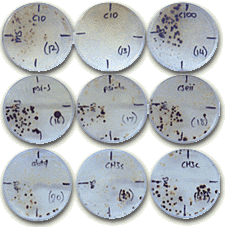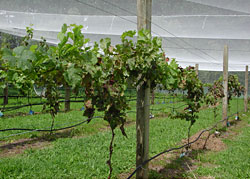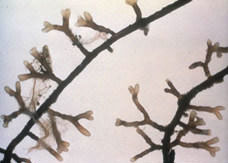| BOTRYTIS
Botrytis is still one of the most important grape diseases
in New Zealand. Incidence and severity depend on a number
of factors and vary from year to year, and from region to
region. Certain varieties are more susceptible than others.
In the last few years a lot of attention has been given to
canopy management as a tool to reduce the problem, and few
people would dispute the importance of canopy management in
relation to Botrytis control.
AgConsult is involved in some new areas where targeted management
can further strengthen Botrytis control.
Inoculum Reduction
Reducing inoculum in the vineyard will reduce disease pressure.
Reducing spore numbers overwintering in the vineyard shows
promise, trials on other crops have shown this strategy can
reduce Botrytis infection at flowering. Spore numbers can
be reduced by maintaining good hygiene in the vineyard. Trials
show they can also be reduced by accelerating the breakdown
of substrate on the vineyard floor on which the spores overwinter,
and possibly by enhancing competition form other organisms
on the vineyard floor.
Strengthening the Vine's Own Defences
This is a very exciting area. Grapevines, like most plants,
have systems in place to deal with pathogenic attack (the
plants immune system). In most cases the plant responds to
external stimuli (like pathogen attack) by producing a number
of different substances that in turn activate a number of
different defence mechanisms. After the initial stimulus it
will take some time for the defence mechanisms to get up to
"full strength", which means that it may be too
late to control the pathogen. Using natural compounds we can
elicit these defence responses, in effect preparing the plant
for pathogen attack. This has been likened to "vaccinating"
the plant. In the case of grapevines, the elicitors increase
levels of resveratrol, one of the main phytoalexins identified
in the immune response. Resveratrol has also been associated
with some of the health benefits of drinking red wine.
Promoting Good Biofilm or Phyllosphere Activity
The phyllosphere or biofilm is the aerial surface area of
plants (leaves, stems etc), the complement of the soil equivalent
rhizosphere. These surface areas are host to many different
microorganisms which on healthy plants colonise a large part
of the biofilm. Promoting good biofilm activity will help
control pathogen attack. Beneficial organisms can inhibit
pathogens through production of inhibitory substances, competition
for nutrients and or space. There are several ways beneficial
biofilm activity can be enhanced, and in vitro trials have
shown the effect of good biofilm activity on Botrytis is very
promising.
We are involved with further research and trials in all three
areas.
PHYLLOXERA
In recent months, the presence of Phylloxera has been confirmed
in one Central Otago vineyard. Although the Central Otago
wine growing area is relatively small, it is growing fast
and has potential to produce some top quality wines. Phylloxera
is already present in many other grape growing areas, but
in most cases phylloxera resistant rootstock has been introduced
to combat the problem. There are still a number of own-rooted
vineyards however where phylloxera is a problem.
Conventional treatment is based on the use of fumigant type
products that can reduce phylloxera numbers significantly,
but long-term success rates are not encouraging. In addition,
the effects of these products may also impact on beneficial
bacteria and fungi in the soil, which in turn can affect vine
performance.
Organic type management aimed at maximising soil and vine
health appear to have the potential to reduce the impact of
phylloxera on vines.
Mostly these approaches maximise biological activity and competition
in the soil, increase beneficial biological activity in the
rhizosphere, and strengthen the vine's own defence system.
Many of the practices used are very similar to organic management
practices in vineyards, although not all would fall in that
category.
These findings are based on work by Don Lotter (as PhD student
at UCDavis) and our involvement with trial work in New Zealand
and California in association with Bio-Start Ltd.
It is important to point out that there is no evidence that
the organic Phylloxera control alternatives kill or even decrease
phylloxera numbers in the soil, at least not in the short
term.
It appears most of the impact of Phylloxera damage to roots
is through secondary infection: after the initial damage caused
by phylloxera, the damaged root is more likely to be invaded
by pathogenic fungi like Pythium and Fusarium. It are these
fungi that most likely do the real damage by "clogging
up the root channels".
The impact of management practices that promote soil biological
activity may be to a large extent by minimising the secondary
infection and damage. Soils with good soil biological activity
and diversity have a significant suppressive effect on pathogens
like Fusarium and Pythium.
Other mode of actions may be (there are others but that would
be outside the scope of this text):- Under organic management
vines are likely to have stronger defence systems to pathogenic
attack (SAR Systemic Acquired Resistance).
- The presence of PGPB -Plant Growth Promoting Bacteria and
other beneficial rhizosphere microbes increase root activity/growth,
which can compensate for the damage done by phylloxera.
Ongoing trials in this area are taking place.

NATURAL
ELICITORS
Plants respond to external stimuli. When attacked by for instance
a fungal pathogen on the leaves, receptors on the leaves will
recognise the pathogen attack and set in motion a series of
defensive actions. There are a number of different mechanisms
that the plant can use to defend itself. These include the
pre-existing systems (for instance wax and cuticle covering
epidermal cells), inhibitors released by the plant to deter
pathogens and others. And there are mechanisms that respond
to pathogen attack through recognition of the pathogen by
the host plant. These are the induced structural and biochemical
defences.
As a result of pathogen attack the plant can activate cytoplasmic
defence reactions, it can change/develop cell wall structures,
it can develop hypersensitive defence reactions or activate
histological defence structures.
In grapevines part of the defence reaction involves phytoalexins,
including a compound called resveratrol. Resveratrol has been
identified as one of the main compounds in the plants defence
against a number of fungal pathogens like Botrytis, in effect
protecting the leaves and fruit from attack as long as resveratrol
concentrations are high enough (in the berries they tend to
decrease over time).
One of the weaknesses in the plants armour is the delay between
recognition of pathogen attack by the vine and the time it
takes to build up the defence systems.
Plants that are in an environment where they are challenged
frequently by pathogens, develop amazingly effective defence
capabilities.
In recent years significant progress has been made in our
understanding of these processes.
By "eliciting" the defence response in the plant
we can help protect it against future pathogen attack. Some
people even go as far as using the term "vaccinating
plants"
How can we prime the plants immune system? We can expose the
plant to a low dose of pathogen inoculum) or a devigourised
strain of the pathogen, but this can still be risky.
There are other ways; there are a number of natural substances
that have similar molecular structure as some of the pathogen
cell wall fragments, and when applied to the surface of the
plant the plant responds as if it is being attacked by a specific
pathogen.
Some researchers have worked with some of the signal compounds
that play a role in the defence response, Salicyclic Acid
derived compounds fall into this category.
AgConsult has been involved with work on grapevines and other
plants using a number of different natural substances to elicit
plant defence responses.
Some of these compounds and products have shown to lift resveratrol
levels in grape vines significantly, creating considerable
interest. Work on commercialising some of these substances
is underway.

MYCORRHIZAS
Mycorrhizas are symbiotic relationships between fungi and
plant roots (the term means literally 'fungus root'). Perhaps
more than 70% of the species of higher plants have these relationships,
and so do many ferns and some mosses. They are as common on
crop plants (cereals, peas, tomatoes, onions, apples, strawberry,
etc) as in wild plant communities and in several cases they
have been shown to be important or even essential for plant
performance.
Generally, mycorrhizas are symbiotic (mutually beneficial)
relationships, in which the fungus obtains at least some of
its sugars from the plant, while the plant benefits from the
efficient uptake of mineral nutrients (or water) by the fungal
hyphae.
Mycorrhizal fungi promote good plant nutrition by obtaining
nutrients from the soil, and exchanging these nutrients with
the plant for carbon. In addition, mycorrhizal fungi can physically
protect roots against pathogens and root-feeding nematodes,
and improve soil structure by binding soil aggregates in to
larger, water-stable aggregates.
The two main types of mycorrhizal fungi are Ectomycorrhizal
and Arbuscular or endo-mycorrhizal fungi. Ectomycorrhizas
are characteristic of many trees in the cooler parts of the
world - for example pines, spruces, firs, oaks, birches in
the Northern Hemisphere and eucalypts in Australia. Grapevines
form association with both types of fungi, but there is a
tendency to find more endomycorrhizal fungi on young vines.
When the vines are 4-8 years old, there appears to be a shift
towards ectomycorrhizal fungi. This has been linked by some
researchers with increased grape quality.
Arbuscular or Endo- Mycorrhizas
Arbuscular mycorrhizas are found on the vast majority of wild
and crop plants, with an important role in mineral nutrient
uptake and sometimes in protecting against drought or pathogenic
attack. It is thought that these fungi colonised the earliest
land plants and that mycorrhizal associations could have been
essential for development of the land flora.
These fungi can extend up to 10 cm away from the roots, and
have access to nutrients that the plant roots do not have.
These fungi are particularly efficient in sourcing phosphorus
and zinc. In addition they will help increase the plants resistance
to certain pathogens.
VAM (Vesicular Arbuscular Mycorrhizal) fungi penetrate the
root cells while ecto-mycorrhizal fungi form a mantle around
the root.
Ecto Mycorrhizas
The fungi involved are mainly Ascomycota and Basidiomycota,
including many that produce the characteristic toadstools
of the forest floor. Most of these fungi can be grown in laboratory
culture but, unlike the wood-rotting fungi, they are poor
degraders of cellulose and other plant wall materials. So
they gain most of their sugars from the living plant roots
in natural conditions.Ecto mycorrhizal fungi can form long
extended hyphae. In one case hyphae were found to extend almost
50 m from the host plant (grapevine).
In ectomycorrhizas the terminal branches of the root system
are highly modified - the roots are short and stubby, covered
with a mantle (sheath) of fungal tissue, and there are fewer
or no root hairs. The fungus takes over the normal nutrient-absorbing
role of the root hairs.

Ectomycorrhizal fungi on typical "stubby" roots
Such roots are seen easily if the undecomposed,
surface litter is scraped away from a forest floor to reveal
the decomposing litter containing a mass of mycorrhizas and
their fungal networks.
FERTIGATION
A significant number of vineyards are now set up for fertigation.
More than likely this number will increase significantly.
The reasons for this increase are varied, they include nutriononal
support for newly planted vines, to address magnesium deficiency
in vines. Fertigation is very effective in lifting phosphorus
levels, and often it is used for postharvest nutrition. Sometimes
it is used to provide general NPK support on low fertility
soils.
Where growers rely heavily on irrigation, nutrients can be
depleted quite rapidly in the drip zone if soils have low
fertility. Basically the vines need to source most of their
nutrients from a very limited soil volume if moisture levels
outside the dripzone are low.
Adding some nutrients to the irrigation water will counteract
this depletion and is a good nutritional management tool that
can be used to regulate vigour and other parameters.
The down side of fertigation is that incorrect use (type of
products, timing, application management) can cause acidification
of the soil and other problems.
In our view there is a general lack of understanding around
fertigation issues. When to use, where to use, what product
etc.
AgConsult can help develop a fertigation program for your
vineyard, based on soil and petiole analysis, the fertigation
system you are using, vineyard (soil) characteristics, yield/quality
desired and other factors.
|

